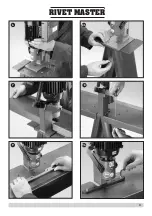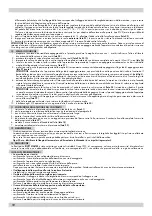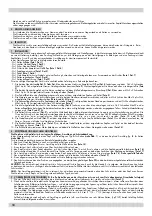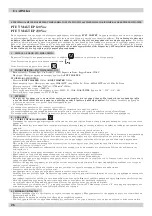
16
10 START-UP
1 - Prepare the chain to be assembled by resting it on the table, take the tie strap (the rivets must be turned upwards), and slip the two ends of
the chain onto the two rivets
(photo 24)
2 - take the pierced tie strap and center it on the two rivets
(photos 25 and 25/A)
3 - grip the chain on both the right and left of the tie strap to be riveted; the recommended distance between your hands should be approx. 20cm
(8”)
(photo 26)
4 - tension the chain, make it slide under the support’s transparent guard and rest carefully one of the rivet of the tie strap on the concave rivet
holder
(photo 27)
5 - at this point, also the protruding part of the drive links will be resting on the chain support guide
(photo 27 point 1)
CAUTION
: check that the position of the chain support guide does not prejudice the correct position of the rivet on the rivet holder.
The guide edge must never touch the tie strap below. It’s recommended to always keep a distance of:
(see
fig. 3)
.
To adjust the guide, loosen the two knobs below, move the guide forward, towards the motor, and backward towards you. Once the correct
position has been found, lock the assembly by tightening the two knobs below again.
6 - turn on the master switch on the top of the box, on the right side of the motor; the machine will start, making the riveting head turn clockwise
(the direction of rotation of the head is indicated by a label with a red arrow, stuck on the front of the motor)
7 - gradually approach the head to the rivet, by pressing the pedal without any sudden movements
(photo 28)
, and start riveting the rivet.
CAUTION
: during the riveting stage, the head begins to revolve and tends to drag the involved section of the chain. After a feeble attempt to
revolve, the chain stops against the plane of the three jaws fastened onto the support plane
(item 8)
, so to assure the operator's safety. Always
wear safety gloves and goggles.
8 - In the event of the rivet being flattened too much or too little, adjust it by means of the adjustment ring nut, so as to increase or decrease its
travel
(photo 29)
9 - after identifying the best adjustment, riveting operations can be initiated on the remaining rivet
10 - lubricate the rivet and the head every 2/3 operations with a drop of oil
(photo 30)
11 REPLACING THE HEAD AND THE RIVET HOLDER
1 - remove the transparent protective shield, by unscrewing the three screws
(photo 31)
2 - to disassemble and replace the head, follows the instructions provided in paragraph
8
3 - take a screwdriver of any shape but long enough
4 - position the screwdriver at the center of the structure, on the underside
5 - identify the seat where you should work, and slightly press it from bottom to top, removing the river holder, that must leave its seat
(photo 32)
6 - install the new rivet holder, driving it from above
(photo 18)
7 - install the protective shield again with great care
(photo 20)
12 MAINTENANCE
- Only perform maintenance jobs after interrupting power to the machine
- The machine must be kept clean so that safety instructions and plates are clearly visible. To clean, use a cloth or swab.
- Do not use compressed air as this could blow metal shavings into vital machine parts.
-
Every 20 hours: lubricate the motor adapter flange and the support (using the two respective greasers).
13 SCRAPPING
The
RIVET MASTER
riveting machine has been made using 90% recyclable materials and consequently, in the event of the machine being scrapped,
do not discard in the environment but make sure it is disposed of through your dealer.
TROUBLESHOOTING
• The machine does not start:
- check that the plug is perfectly connected to the outlet
- check that the power cable of the machine is not damaged
- check that the outlet is energized
- check that no fuses have blown in the outlet
- check that the automatic circuit-breaker has not tripped.
If, after these operations, the failure to start can be attributed to the machine, have it checked by an authorized service center.
• The connection of the machine to the mains makes the automatic circuit-breaker trip:
- contact an authorized service center.
• The machine’s electrical motor is overheated:
- check that the voltage indicated on the data plate meets the mains voltage
- check that the motor’s cooling fan is turning properly and is not damaged
- check that the head holder shaft is turning freely when the motor is OFF.
If the problem persists, contact an authorized service center.
• The direction of rotation of the head is the opposite of that indicated on the machine:
- contact an authorized service center
• The machine shows signs of anomalous vibrations:
- check the adjustment of the four supporting feet of the frame
- check that the motor unit is secured to the base unit
- check that all the elements of the structure are securely fastened
If the problem persists, contact an authorized service center.
Содержание RIVET MASTER 120Vac
Страница 2: ...RIVET MASTER 2 5 3 2 4 1 9 8 1 2 3 4 7 5 4 6 FRONT FRONT ...
Страница 3: ...RIVET MASTER 3 6 9 9 A 6 A 7 8 ...
Страница 4: ...RIVET MASTER 4 15 14 10 10 A 11 12 13 ...
Страница 5: ...RIVET MASTER 5 16 17 18 19 21 20 ...
Страница 6: ...RIVET MASTER 6 22 23 24 25 26 25 A ...
Страница 7: ...RIVET MASTER 7 32 31 27 28 1 29 30 ...
Страница 51: ......
















































